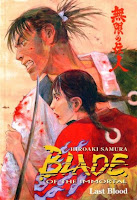 Creator: Hiroaki Samura
Creator: Hiroaki Samura
U.S. publisher: Dark Horse
ISBN: 9781593074685
Released: February 2006
Original release: 2003
Awards: Eisner Award, Japan Media Arts Award
Trickster is the fifteenth volume in the English-language edition of Hiroaki Samura’s award-winning manga series Blade of the Immortal. Because the series has been collected slightly differently between the Japanese and English releases, Trickster is actually equivalent to the fourteenth volume published in Japan in 2003. Trickster was released three years later by Dark Horse in 2006. Since Blade of the Immortal‘s beginning it has garnered numerous awards and honors. Among these are a Japan Media Arts Award from 1997 and an Eisner Award from 2000. Along with the end of previous volume, Last Blood, Trickster marks the beginning of the fourth major story arc in Blade of the Immortal. Last Blood established the groundwork for some major plot developments, so I was very interested in seeing how things would play out in Trickster.
Manji is a wanted man. He has killed more than one hundred men, and that was before he became immortal. While he and Giichi are “discussing” Manji’s joining the Mugai-ryū—a group of death row inmates serving the bakufu as assassains to earn their freedom—Rin is captured by the Ittō-ryū. The bakufu isn’t the only group interested in Manji and his bloody history. Serving as Rin’s bodyguard, Manji’s taken out quite a few of the Ittō-ryū’s best fighters. A few of the remaining members want revenge and are willing to hold Rin captive until they get it. Meanwhile, the rest of the Ittō-ryū is recovering from a devastating assault which left a majority of the members of the sword school dead. With only the core remaining, the Ittō-ryū is developing plans for its own attack, striking back at the bakufu in return for its betrayal.
The setup and location, an abandoned quarry, for the Ittō-ryū’s confrontation with Manji and Giichi in Trickster is marvelous. Unfortunately, the resulting combat, with the exception of a few choice sequences, was somewhat disappointing. The fight scenes are fantastic in concept but they are rather difficult to follow. How the series has been adapted for the English edition, a sort of cut-and-paste method, compounds the issue. I know that Samura can create phenomenal fight choreography, I’ve seen it in previous volumes of Blade of the Immortal, which is why Trickster didn’t quite meet my expectations. The fights in Trickster had a tremendous amount of potential and could have been incredibly dynamic but sadly their execution largely seemed to be wasted opportunity. But even considering this, Samura is still able to pull off some stunningly effective moments.
Although I was unhappy with some of the combat in Trickster, over all I was still pleased with the volume—there was some nice character and plot development. Several members of the Ittō-ryū who have only really been seen in previous volumes of Blade of the Immortal were more thoroughly introduced in Trickster. Some won’t last very long while others have been set up to play an important role in the story. And then there’s Rin who has been important from the beginning and continues to grow and evolve. Rin has been separated from Manji for several volumes leading up to Trickster. Now that they have been reunited it is readily clear that she has become very attached to him. Manji started out as a body guard but by now he means much more to Rin than just that. It’s important that these feelings have been established since by the end of Trickster, things are really not looking good for Manji. I am very interested in seeing how things develop in the next volume, Shortcut.




